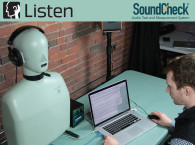
The updated Portland Tool & Die BTC-4149 Bluetooth measurement interface now has a new, larger color screen for improved ease of operation, among other improvements. Since 2014, Portland Tool & Die signed an exclusive worldwide distribution deal with Listen, Inc., providers of the industry standard SoundCheck audio test software.
The interface now supports the aptX HD and aptX-Low Latency Bluetooth protocols for accurate measurement of high definition and low latency Bluetooth audio devices, in addition to the standard aptX, CVSD and mSBC codecs previously available. The BTC-4149 is designed as a R&D interface, testing both sink and source devices with full control over Bluetooth protocol settings, including explicit control over codec choice and transmitter power, as well as various pairing options.
Also available is a lower cost production tool, the BQC-4149. This tests Bluetooth Sink devices only, and offers only the standard aptX, CVSD and mSBC, along with more limited control of Bluetooth parameters. This model has been updated to use the same chipset as the BTC-4149 to ensure accurate production line replication of R&D tests for those companies who use both interfaces.
Both interfaces integrate seamlessly with the SoundCheck audio test and measurement system, so that all parameters can be set and modified from within a test sequence for fully-automated testing of Bluetooth devices. This accelerates testing, particularly on the production line as it avoids the need to manually adjust Bluetooth settings, reducing the possibility of error. It also enables a device to be tested using multiple Bluetooth protocols and settings by taking sequential measurements using different settings in one continuous test.
www.listeninc.com






